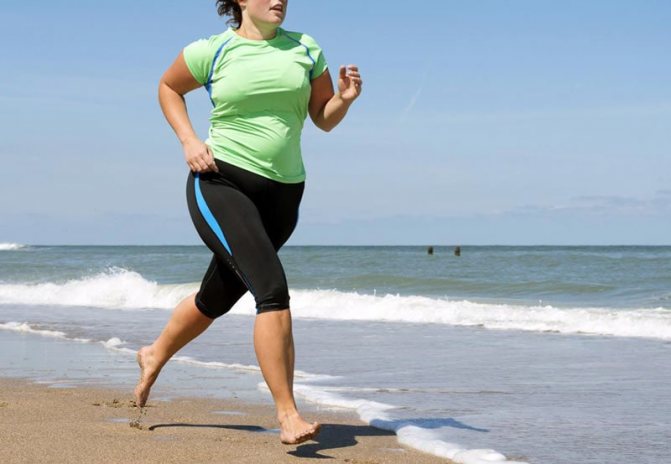
Ask just about any amateur runner why they started running, and chances are you’ll get the answer that the first goal was to lose weight. The paradox is that the “running but not losing weight” situation is very common. Running coach Ekaterina Preobrazhenskaya told why this annoying problem arises and how to deal with it.
Running is one of the most energy-consuming types of physical activity, on average you can burn about 500 kcal per hour. It would seem what could be better for weight loss? But there are a number of common misconceptions that get in the way of achieving the desired goal.
I run a lot, and I have a brutal appetite
Weight loss does not come from training as such, but from calorie deficit. If you run for an hour a day, but at the same time eat 500 kcal more than the norm, the weight will not decrease. Running is a good way to use up calories, but you don’t have to completely compensate for them with food in order to lose weight.
I eat very little
Severe malnutrition puts the body under stress and begins to accumulate stores at every opportunity and reluctantly to spend them. Moreover, “hunger strikes” tend to lead to overeating on certain days, and as a result, the entire “accumulated” calorie deficit is compensated by food for one excessive meal.
I run fast, but there is no effect
With intense running, energy is produced mainly in an anaerobic (that is, anoxic) way – glycogen, not fat, is involved in this type of energy exchange. Of course, if you sustain a calorie deficit after such a run, it will contribute to weight loss, but you should not expect that increasing the intensity of the load will directly lead to the loss of kilograms, you should not.
50 developmental exercises for training at home
I am guided by the number on the scale
Muscles are denser than adipose tissue, which means they are heavier. With regular exercise, muscles develop, so weight can increase. The composition of the body may change, and the number on the scales will stand still.
Running makes me gain weight quickly
This situation can happen, only the weight gain is not due to an increase in fat tissue as well due to water accumulation. Water is needed for muscle recovery as well as nutrient absorption. In addition, since the body loses a lot of fluid while running, it begins to store it for future use.
I run monotonously
The human body has excellent ability to adapt to circumstances, and if the loads are monotonous and monotonous , ultimately our body gets used to them, which subsequently negatively affects both sports performance and the loss of extra pounds.
I want quick results
By weighing every day, you really you’re not tracking fat gain or loss, but rather random fluctuations in hydration levels. It makes more sense to set long-term goals and expect smooth weight loss.

So how do you run and lose weight? Here are 4 basic rules of running for weight loss.
Keeping an eye on your calorie deficit
First, you need to understand that there is no “magic pill” for weight loss, and running cannot become it. The loss of adipose tissue occurs due to a calorie deficit. A calorie deficit is a situation where the number of calories burned over a period of time (for example, a day) is greater than the number eaten.
To lose a pound of fat, you need to “not finish” about 3500 kcal. Nutritionists recommend keeping the difference between calories burned and consumed in the range of 300 to 600 kcal per day (then, if you use simple math, it will take 6 to 12 days to lose one kilogram). This deficiency does not stress the body, nor does it create a hunger sensation that can lead to overeating.
How many times do you need to repeat the exercise?
Lift your breasts with data exercises can be done if you strictly follow certain rules, namely:
- you should do at least 3, ideally 5 approaches;
- the number of repetitions from 10 and up to 20 times depending on endurance and physical level. training a person.Before moving from one approach to the next, you need to make a short pause (one minute). If the body does not have time to “come to its senses” in one minute, the rest between sets can be increased to two, but during the training period you should try to come to the first respite option.
As for the frequency of training, they should be done three times in Week. This will be quite enough to tighten the chest and make it as attractive as possible.
When working with dumbbells, use a light weight (0.5 – 1 kg). If these attributes are absent, you can fill half-liter bottles with water and start exercising.
Regularly performing the above training complex and observing all the rules, the first positive results can be seen after a month. Then you will need to increase the load (dumbbell weight, number of repetitions), since the muscles will already get used to the exercises that you have been doing for a month and will no longer “react” to your actions.
Run with low intensity
Secondly, for optimal fat consumption during physical activity, it must take place in the aerobic zone, i.e. on the pulse, in which energy exchange occurs with the use of oxygen, and the body uses fat for fuel. This is individual for each person, but, as a rule, this is a load below the aerobic threshold. This is often a low-intensity running, in which you can talk for more than 30 minutes.
You can find out your heart rate thresholds and fat burning schedule by going through functional testing in the laboratory. It is not worth calculating the heart rate zones according to the formulas that the Internet is swarming with – this is the “average temperature in the hospital,” nothing more. Your performance can be drastically different from the average. Moreover, some people burn fat above the aerobic threshold.
Exercises to increase the elasticity of the bust
Bench press
A huge number of women have noticed that the forms acquire noticeable elasticity after performing this exercise. It should be performed while on the bench.
The technique is quite simple:
- take a comfortable position, sitting on the bench lying on your back;
- pre-adjust the height of the racks so that it is convenient to grip the barbell;
- remove the barbell (or the bar from it, depending on your preparation) and lower it very close to your chest, taking a breath;
- as you exhale, lift the weight up.
Exercises on an incline bench should be performed in the same way, but in this case, the bar should be lowered closer to the upper chest zone (in the first case, lowering is performed towards the center of the bust).
Push-ups
Being in the gym, you can perform not only classic push-ups (from the floor), while placing your arms as wide as possible to work out well the pectoral muscle, but also from the bench.
The exercise should be performed as follows:
- descend on exhalation;
- rise while inhaling.
Remember, the lower you go, the more the pectoral muscle works. When pushing up from the bench, you can pre-adjust the height, which will allow even poorly trained women to successfully perform the exercise. Over time, the level of the bench can be lowered and, as a result, you come to the exercise on the floor.
Working with dumbbells
The exercise is performed similarly to the one written earlier, but in the gym you can increase the load with each approach, starting with the minimum possible, and by 3-4 approaches, change the dumbbells to heavier ones.

Alternate slow running with interval training
Thirdly, running at a “fatty” pace should be alternated with interval training. This will prevent the body from getting used to the monotonous load, and will also develop muscles, which will lead to more calorie expenditure.
It should be borne in mind that during high-intensity workouts, not fats are used, but glycogen, which is contained in muscles and liver. If after training you do not replenish its reserves (close the “carbohydrate window”), then for several hours glycogen will continue to be consumed, which will negatively affect recovery. Therefore, after such a workout, it is advisable to eat something carbohydrate and light, for example, a green apple. However, you do not need to get carried away – since energy is expended even after such a workout, the process of fat burning starts, and it is advisable to make the main meal mainly protein.
Is it possible to gain muscle mass by running?
This article will focus on running, specifically: “Is running useful for people who want to gain muscle mass?” You can read in the article about when is the best time to run, in the morning or in the evening to throw off, and today we will talk about another use of running. Namely, is it possible to gain muscle mass by running?
To date, there are two main theories on this score. Adherents of one theory believe that running can only reduce mass, supporters of another theory believe that running acts as an anabolic.
The former believe that running reduces mass, guided by the fact that it burns weight, moreover, equally both fat and lean body mass. Plus, running takes a lot of strength and energy, which does not allow the athlete to give all the best in the main workouts in the gym.
The latter examined the situation in more depth. They believe that running is a natural anabolic. For muscle growth, not only nutrients are needed, but also their delivery through the bloodstream to muscle groups (we will not delve into the very essence of the process, since there is not enough space for this).
In their opinion, a day is needed run 5-10 km. Running by itself does not affect muscle mass; it can only create physiological and biochemical conditions for effective training and weight gain.
Over time, the situation has changed slightly. And more and more of those who, believed that running burns muscle mass and stood firm, have now begun to add running to their training program, all in the same desire to build mass. The methods, by the way, are different for everyone. Some insert running before the main workout, others make a separation between running and the main workout, but it is better to separate, since scientists have proven that this method is more effective.
In conclusion about the theory “running is friend or foe”, I would like I would add that quite a few people already use running as a natural anabolic and, by their own example, or rather, by the example of their body, show the benefits of running for gaining muscle mass.
Of course, no one will give you a hundred percent guarantee, but if you think logically and look at the facts, the theory that running helps to gain muscle mass can be considered correct. Using such an anabolic steroid, you can definitely keep your health. Since moderate running has not harmed anyone yet, and even helped to strengthen the heart muscle.
Good luck with your training. Sports Factor
Rate this article:
(1 rating, average: 1.00 out of 5)
Share with your friends on social networks:
Periodically run on an empty stomach

Fourthly, the body will be especially active in using adipose tissue as a source of energy during a slow run on an empty stomach. The fact is that after sleep, the level of glucose in the blood is low, and with a low intensity load, the body will consume fats. This is especially effective if strength training was done the night before and muscle glycogen stores are low. True, you should not get carried away with jogging on an empty stomach, so as not to get used to it – then the effect will decrease. Moreover, be sure to drink a glass of water before such a run, the duration of which can be 30-40 minutes.fortable and painless as possible.